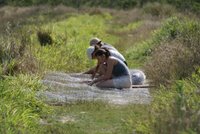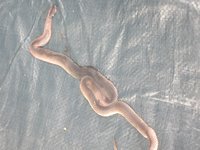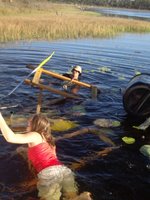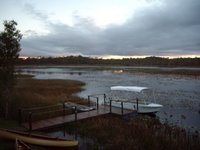Enclosure
The crocs are going to be a little pissed off when they arrive. If you were happily sitting out the front of your house one day, minding your own business and then suddenly some bastard throws a net over you, ties you up, gives you a little grope to see whether you’re male or female, blindfolds you, and then drags you to some place you’ve never been before and lets you go, well you’d probably be a little pissed off too.
Ideally we’d like our crocs to stay around, hopefully have a little romance and, all things going well, pop out a few kids. If we chuck them straight in the water after their capture ordeal, chances are they’ll take the first exit they come across and will disappear back down the river in no time.
To (hopefully) stop this we’re going to ease them into their new home by putting them in an enclosure for a week or two after we bring them to the wetlands (add ‘forced imprisonment’ to our charges of ‘kidnapping’). This will give them a chance to calm down and will allow them to familiarize themselves with the area. It also gives us a chance to keep an eye on them for a while so we can make sure they’re fit and well after their move.
Obviously this means I need to build a temporary enclosure to put them in. After my stint in Ecuador at the Santa Martha Animal Rehab Center, I’ve got a little experience in knocking up makeshift, low budget (i.e. dodgy) animal pens. I go through a few designs on paper. The crocs need water, enough that they can submerge; they need direct sunlight to warm themselves and they need shelter from the wind and the sun. They can’t really jump over fences of any reasonably height but they can dig under them.
 I get my volunteer labour force cracking. While a few of them wire mesh together and rig up supports I set to work preparing a site. I find a spot where the bank isn’t too steep on the shore but drops fairly quickly once underwater. This gives the crocs enough water to play in while still allowing them to easily slide in and out of the water. Unfortunately the bank is covered in waist-high weeds and the shallows are choked with reeds. These have to go.
I get my volunteer labour force cracking. While a few of them wire mesh together and rig up supports I set to work preparing a site. I find a spot where the bank isn’t too steep on the shore but drops fairly quickly once underwater. This gives the crocs enough water to play in while still allowing them to easily slide in and out of the water. Unfortunately the bank is covered in waist-high weeds and the shallows are choked with reeds. These have to go. I have a crack at the weeds with the whipper snipper but the thicket proves to be too much for it. I dig out a rusty old cane knife from the back of the tool shed and using my machete skills from Ecuador manage to clear out the bulk of the weeds after a few hours work. You just can’t beat a good, old-fashioned machete for getting the job done.
The reeds in the water prove a little more difficult however. For these I have to get into the water and dig out the roots with a shovel. My volunteers make a token effort to get into the murky water but none are keen to go in much past their ankles. I’m on my own for this one.
I’m waste deep in the water when I begin to feel things wriggling against my legs. It’s not a pleasant sensation. Lifting my legs reveal hideous, alien-looking, black worms wriggling against my skin: leaches. I swipe them away quickly and carry on but I can’t go more than a few minutes without a fresh swarm homing in. Eventually one gets me and it’s a monster, as long as my finger and twice as fat. There’s nothing pretty about it either.
You hear people talk about burning leaches off with a cigarette lighter or pouring salt over them so they’ll drop off. I’m sure these are all highly affective techniques but I’d like to see you bother with either of these when you’re waste deep in water with a giant, black, slimy leach stuck to your leg, sucking blood out by the litre.
 I grab hold of the little bastard, rip him off and peg him as far as I can. It’s all done in one swift, instinctive movement; the brain has no say in the matter whatsoever. When the brain does finally kick in, it has no complaints (in fact it’s quite complementary of the distance the thing flew) and simply adds the hopeful thought that something will eat the evil little bastard before it gets back to the safety of the reeds.
I grab hold of the little bastard, rip him off and peg him as far as I can. It’s all done in one swift, instinctive movement; the brain has no say in the matter whatsoever. When the brain does finally kick in, it has no complaints (in fact it’s quite complementary of the distance the thing flew) and simply adds the hopeful thought that something will eat the evil little bastard before it gets back to the safety of the reeds.The bleeding doesn’t stop of course; not for days. I finish ripping out the weeds as quickly as I can (the volunteers, reluctant before, are now not going anywhere near the water). The job is finally done and we put up the fencing, furnish the cage with a little sand and even decorate it with some nice logs. I can only hope my blood has washed away before we get any crocs in there developing a taste for it.








